
The Atelidae are one of the five families of New World monkeys now recognised. It was formerly included in the family Cebidae. Atelids are generally larger monkeys; the family includes the howler, spider, woolly, and woolly spider monkeys. They are found throughout the forested regions of Central and South America, from Mexico to northern Argentina.

The white-cheeked spider monkey is a species of spider monkey, a type of New World monkey, endemic to Brazil. It moves around the forest canopy in small family groups of two to four, part of larger groups of a few dozen animals. This monkey feeds on leaves, flowers, fruits, bark, honey and small insects, and it is an important means of seed dispersal for forest trees. Females give birth after a 230-day gestation period. The population of this monkey is decreasing as its forest habitat is lost to soybean production, deforestation and road construction. It is also regarded as a delicacy and hunted for food. For these reasons, the International Union for Conservation of Nature has assessed the animal's conservation status as being "endangered".
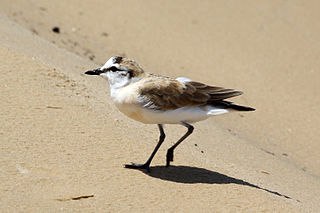
The white-fronted plover or white-fronted sandplover is a small shorebird of the family Charadriidae that inhabits sandy beaches, dunes, mudflats and the shores of rivers and lakes in sub-saharan Africa and Madagascar. It nests in small shallow scrapes in the ground and lays clutches of one to three eggs. The species is monogamous and long-lived, with a life expectancy of approximately 12 years. The vast majority of pairs that mate together stay together during the following years of breeding and retain the same territory. The white-fronted plover has a similar appearance to the Kentish plover, with a white fore crown and dark bands connecting the eyes to the bill.
The Pashford pot beetle, Cryptocephalus exiguus, was a small beetle endemic to the east of England.
The many-lined salamander is a species of salamander in the family Plethodontidae. It is the only species of the monotypic genus Stereochilus. It is endemic to the United States.

The southern nightingale-wren, also known as the scaly-breasted wren, is a species of bird in the family Troglodytidae. It is found in Bolivia, Brazil, Colombia, Costa Rica, Ecuador, Panama, Peru, and Venezuela.

Epinephelus marginatus, the dusky grouper, yellowbelly rock cod or yellowbelly grouper, is a species of marine ray-finned fish, a grouper from the subfamily Epinephelinae which is part of the family Serranidae, which also includes the anthias and sea basses. This species is the best known grouper species of the Mediterranean Sea and North Africa coast.
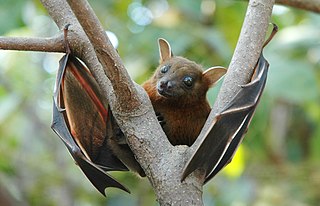
The lesser short-nosed fruit bat is a species of megabat within the family Pteropodidae. It is a small bat that lives in South Asia and Southeast Asia. It weighs between 21 and 32 grams, and measures 70 to 127 millimetres. It occurs in many types of habitat, but most frequently in disturbed forest, including lower montane forest and tropical lowland rain forest, plus gardens, mangroves, and vegetation on beaches.

The Syrphinae constitute one of the three subfamilies of the fly family Syrphidae. Most larvae of this subfamily feed on aphids. It is a monophyletic group with more than 1,600 species.
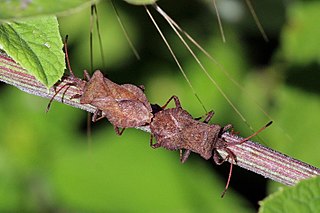
Coreus marginatus is a herbivorous species of true bug in the family Coreidae. It is commonly known as the dock bug as it feeds on the leaves and seeds of docks and sorrels. It is a medium-sized speckled brown insect, between 13 and 15 mm long as an adult, with a broad abdomen. It occurs throughout Europe, Asia and northern Africa. It is often found in dense vegetation, such as hedgerows and wasteland.

The tessellated blenny is a species of combtooth blenny found in the western Atlantic ocean.

Cryptocephalus sericeus is a species of beetle of the family Chrysomelidae, subfamily Cryptocephalinae.
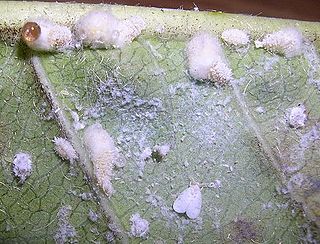
Paracoccus marginatus, commonly known as the papaya mealybug, is a small sap-sucking insect in the mealybug family, Pseudococcidae. It is found on a number of different hosts, including economically important tropical fruit trees and various ornamental plants.
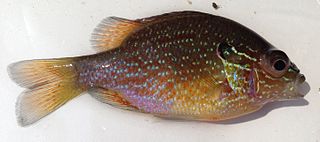
The dollar sunfish is a species of freshwater fish in the sunfish family of order Perciformes. It is categorized as a warm water pan-fish. Early settlers said that this species of sunfish resembled a European species they called bream. Historically it has been found along the Southern Atlantic coastal drainages from North Carolina to Florida, and west to Texas. Lepomis marginatus mainly feeds on detritus and filamentous algae as well as a few terrestrial insects. The juvenile and mature fish do not have many predators, but the eggs in the nest are in danger of predation from a few different species of fish.

Cryptocephalus trimaculatus is a species of cylindrical leaf beetle belonging to the family Chrysomelidae, subfamily Cryptocephalinae.

Cryptocephalus virens is a cylindrical leaf beetle belonging to the family Chrysomelidae, subfamily Cryptocephalinae. The species was first described by Christian Wilhelm Ludwig Eduard Suffrian in 1847.

Cryptocephalus flavipes is a beetle belonging to the family Cryptocephalus.

Choerades marginata is a species of robber fly found in Europe.
Deporaus marginatus, commonly known as the mango leaf-cutting weevil, is a species of leaf weevil in the beetle family Attelabidae. It is a light tan colour with black elytra, and is found in tropical Asia where it is a pest of mango.

Cryptocephalus moraei is a species of beetle from the genus Cryptocephalus. The species was originally described by Carl Linnaeus in 1758.

















